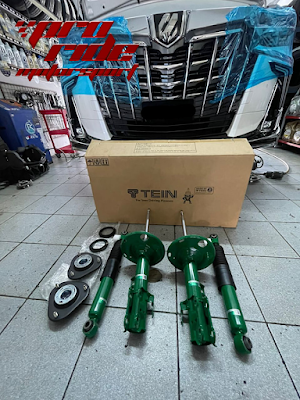Upgrading to High-Performance Tires
High-performance tires are a double-edged sword that improve grip greatly, but make control extremely difficult when exceed their limits. Tires must be chosen by carefully considering how they will complement factors such as the vehicle's power and other characteristics.
INCREASED GRIP/RIGIDITY
Grip and rigidity are the most important characteristics of high performance tires.
Slicks-tires designed especially for racing-boast the best of both. The rubber compound they are made from gives excellent grip by melting slightly and sticking to the track surface when it heats up, and in order to maintain rigidity in the part of the tire that makes contact with the road, they have no grooves. Road tires designed for high-performance driving take a similar, if slightly less extreme, approach, using softer rubber compounds, and thread patterns with very shallow grooves. However, on wet surfaces, grooves are essential to ensure that the tires can effectively rid themselves of water, and the more there are, and the deeper they are, the better. Therefore, deciding to what degree to balance wet and dry characteristics is a key element of tire choice.
WIDTH
Increasing the width of the tires increases the amount of the surface that makes contact with the ground, and therefore increases grip. However, grip is not only affected by how much contact the tire has with the ground, but also by how much load is placed on the tire. Therefore, fitting super-wide tires to a lightweight car may not improve grip significantly, as there may not enough weight pressing down on them. Another problem can arise when over-sized tires are fitted to an underpowered car, is that much power is used up counteracting the tires grip that the car loses speed as a result. For these reasons, the choice of tire size should be based on the weight and output of the vehicle.
Base on my own experience,for average car it is recommended that:
40-55hp - 165mm
55-70hp - 175mm
70-80hp - 185mm
80-100hp - 195mm
P/S: this figure is strictly base on my own experience..

LOW-PROFILE
The profile of a tire describes its height compared to its width. Using low-profile tires is a way of increasing wheel size without increasing diameter, and does not necessarily mean increasing width as well. One of the main benefits of low profile tires is that the shorter sidewall bends less during cornering and braking, and this higher rigidity results in improvements in steering response and handling. However, lowering tire profiles increase wheel size, which can mean more unsprung weight if taken too far, and of course this can adversely affect maneuverability. In competitive driving, larger wheels and low profile tires are selected to make space for larger, more effective brakes.
To improve handling especially during cornering, just change to 10-30mm lower profile than OEM setup. Please remember that lower profile = Improved handling = less comfort.
COMPOUND
The rubber used to make the part of the tire that makes contact with the ground is called the compound, and dictates the tire's grip. High-performance tires that prioritize grip use soft compounds that adhere to the road surface better, and racing tires even melt slightly under heat so that they can cling to the road surface better. However, while soft compounds have better grip, they wear down much more quickly, and harder compounds are more durable. It is important to understand the characteristics of the compound used in order to choose the right tires. Drivers should also be aware that rubber hardens over time, and new tires will gradually lose grip because of this, particularly those made from softer compounds

THREAD PATTERN
The series of grooves cut into the surface of a tire is known as the tread pattern, and is designed to maintain grip in wet conditions by ridding the tire surface of water. However, in dry conditions, these grooves reduce rigidity, and can cause the surface of the tire to sway under heavy load, such as when cornering, braking and accelerating. Because of this, the slick tires used for racing have no grooves whatsoever, and semi-racing tires use the minimum number of grooves that are as shallow as possible, in order to maintain rigidity.
In order to decide for an ideal set of tires for your ride, you have to take into consideration of all the factors above. Select base on your vehicle's weight & engine output. Even the best tire if not match correctly, it will not function the way it suppose to. It's not the tire faults, it's just a wrong choice. So before you make any decision, take into consideration of OEM setup. Never go below them & never go too far away from OEM setup.
Example (wira -60+whp)
Stock
175/70/13
Modded (90+whp)
In order to increase handling, can opt for
195/50/15
If anything more than 100whp & increase in car's weight,
it is recommend that larger size with lower profile is match.
Maybe can opt for:
205/45/16
or
205/40/17
Whatever the tire manufacturer specification & feature are always quite true if we match the right size tire to the right vehicle.
For example,
Yokohama Parada Spec-2 195/50/15 works very well on modded 4G15 wira.
but if the engine output have been dramatically increase like using 4G93T of 4G92 Mivec, then definitely this size will not be sufficient.
So choose wisely after considering the factors above and according to your vehicle's weight & engine output.
GOOD LUCK & Enjoy Shopping!



Comments